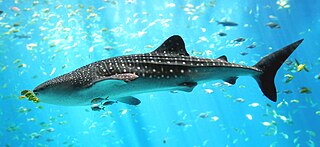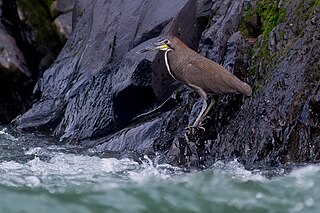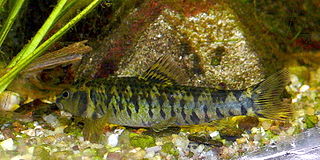
Carpet sharks are sharks classified in the order Orectolobiformes. Sometimes the common name "carpet shark" is used interchangeably with "wobbegong", which is the common name of sharks in the family Orectolobidae. Carpet sharks have five gill slits, two spineless dorsal fins, and a small mouth that does not extend past the eyes. Many species have barbels.

The zebra shark is a species of carpet shark and the sole member of the family Stegostomatidae. It is found throughout the tropical Indo-Pacific, frequenting coral reefs and sandy flats to a depth of 62 m (203 ft). Adult zebra sharks are distinctive in appearance, with five longitudinal ridges on a cylindrical body, a low caudal fin comprising nearly half the total length, and usually a pattern of dark spots on a pale background. Young zebra sharks under 50–90 cm (20–35 in) long have a completely different pattern, consisting of light vertical stripes on a brown background, and lack the ridges. This species attains a length of 2.5 m (8.2 ft).

Pseudoplatystoma is a genus of several South American catfish species of family Pimelodidae. The species are known by a number of different common names. They typically inhabit major rivers where they prefer the main channels and tend to stay at maximum depth, but some species can also be seen in lakes, flooded forests, and other freshwater habitats. They have robust bodies, and are important food fish. Recently, their population size has been on the drastic decline due to a variety of factors including overfishing and habitat destruction due to the construction of hydroelectric dams.

The reticulated swellshark is a catshark of the family Scyliorhinidae. The Reticulated swellshark is found in the western Pacific Ocean between latitudes 21° N and 28° S, at depths between 220 and 450 m. It is a blunt snouted shark with an inflatable stomach, narrow eye slits and a pattern of spots and lines covering its body. It can grow up to 80 cm in length.

The barred conger is a species of conger eel that lives in the tropical western and central Indo-Pacific region. It is also known as the barred sand conger. It is a bottom-dwelling fish and is found in the waters around Madagascar, Indonesia, the Marshall Islands, Hawaii and Tahiti and some other island groups.

The fasciated tiger heron is a species of heron in the family Ardeidae. It is present in southern Central America and parts of northern and central South America, where its natural habitat is rivers.

Pseudoplatystoma fasciatum or barred sorubim or barred catfish is a species of long-whiskered catfish native to the Suriname, Corantijn and Essequibo. The nocturnal predator feeds mainly on other fish and crabs. Females reach a more notable size. They become sexually mature at 56 cm (22 in), males at 45 cm (18 in) and this species reaches a maximum length of 90 cm (35 in) TL. Fecundity seems to be estimated at 8 million eggs per kg, but was recently measured in aquaculture at a lower, and more likely number of 150,000 eggs laid per kg.

Davus fasciatus, commonly known as the Costa Rican tiger rump, is a species of a new-world tarantula native to Costa Rica. This is a terrestrial species with a maximum legspan of 12 centimetres (4.7 in), which makes it a rather small tarantula species, yet it is one of the largest of its genus.
Dipteropeltis hirundo is a little-known species of fish louse. It is an ectoparasite of fish in South America, including piranhas and Pseudoplatystoma fasciatum.

Characidium fasciatum, the darter characin, is a fish in the family Characidae.
Melanostoma fasciatum is a species of hoverfly found in New Zealand, where it is common in agricultural fields and gardens. Locally dense populations of this hoverfly species might effectively reduce pest infestation. Hence, they are perhaps an effective natural and non-toxic bioagent that may control and reduce aphid and small caterpillar populations.
Protonarthron fasciatum is a species of beetle in the family Cerambycidae. It was described by Stephan von Breuning in 1936.
Anobrium fraterculum is a species of beetle in the family Cerambycidae. It was described by Galileo and Martins in 2002. It is known from Brazil.
Anobrium leuconotum is a species of beetle in the family Cerambycidae. It was described by Galileo and Martins in 2002. It is known from Brazil.
Anobrium punctatum is a species of beetle in the family Cerambycidae. It was described by Galileo and Martins in 2002. It is known from Brazil.
Anobrium rugosicolle is a species of beetle in the family Cerambycidae. It was described by Galileo and Martins in 2002. It is known from Peru and Brazil.
Anobrium simplicis is a species of beetle in the family Cerambycidae. It was described by Galileo and Martins in 2002. It is known from Brazil.
Anobrium luridum is a species of beetle in the family Cerambycidae. It was described by Stephan von Breuning in 1940. It is known from Brazil.
Anobrium minimum is a species of beetle in the family Cerambycidae. It was described by Martins, Galileo and de Oliveira in 2009. It is known from Brazil.
Anobrium oberthueri is a species of beetle in the family Cerambycidae. It was described by Belon in 1902. It is known from Ecuador, Bolivia and Brazil.








